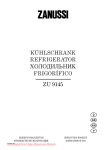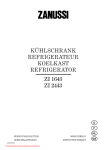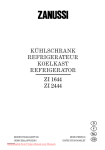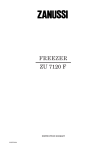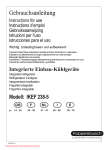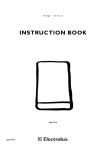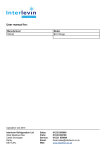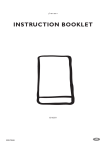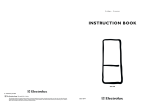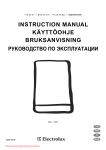Download AEG Electrolux ERU 13300 Specifications
Transcript
fridge - freezer INSTRUCTION BOOK ERU 13300 2222 782-80 Downloaded from Fridge-Manual.com Manuals t Disposal of old appliances The symbol on the product or on its packaging indicates that this product may not be treated as household waste. Instead it shall be handed over to the applicable collection point for the recycling of electrical and electronic equipment. By ensuring this product is disposed of correctly, you will help prevent potential negative consequences for the environment and human health, which could otherwise be caused by inappropriate waste handling of this product. For more detailed information about recycling of this product, please contact your local city office, your household waste disposal service or the shop where you purchased the product. CONTENTS Instructions for the installer Instructions for the user Important Safety Instructions 3 Technical specifications 10 Description of the appliance Use 4 5 Installation 10 Cleaning the interior Starting-up Temperatur control Fresh food refrigeration Freezing fresh food Storage of frozen food Thawing Ice-cube production Movable shelves Positioning the door shelves Food protection 5 5 5 5 5 5 5 6 6 6 7 Hints 7 Hints for refrigeration Hints for freezing Hints for storage of frozen food 7 7 7 Maintenance 8 Defrosting Periodic cleaning Periods of non-operation Interior light 8 8 8 9 Customer service and spare parts Positioning Electrical connection Grid preparation Door reversal Inner door reversal Building the appliance in under a worktop Fitting the plinth 10 2 Downloaded from Fridge-Manual.com Manuals 10 11 11 11 11 11 14 IMPORTANT SAFETY INSTRUCTIONS It is most important that this instruction book should be retained with the appliance for future reference. Should the appliance be sold or transferred to another owner, or should you move house and leave the appliance, always ensure that the book is supplied with the appliance in order that the new owner can be acquainted with the functioning of the appliance and the relevant warnings. These warnings are provided in the interest of safety. You must read them carefully before installing or using the appliance. General Safety ■ ■ ■ ■ ■ ■ ■ ■ ■ ■ ■ This appliance is designed to be operated by adults. Children should not be allowed to tamper with the controls or play with the product. It is dangerous to alter the specifications or modify this product in any way. Before any cleaning or maintenance work is carried out, be sure to switch off and unplug the appliance. This appliance is heavy. Care should be taken when moving it. Ice follies can cause frost burns if consumed straight from the appliance. Take utmost care when handling your appliance so as not to cause any damages to the cooling unit with consequent possible fluid leakages. The appliance must not be located close to radiators or gas cookers. Avoid prolonged exposure of the appliance to direct sunlight. There must be adequate ventilation round the back of the appliance and any damage to the refrigerant circuit must be avoided. For freezers only (except built-in models): an ideal location is the cellar or basement. Do not use other electrical appliances (such as ice cream makers) inside of refrigerating appliances. ■ Use ■ ■ ■ ■ ■ Service / Repair ■ ■ ■ Any electrical work required to install this appliance should be carried out by a qualified electrician or competent person. This appliance should be serviced by an authorised Service Centre, and only genuine spare parts should be used. Under no circumstances should you attempt to repair the appliance yourself. Repairs carried out by inexperienced persons may cause injury or more serious malfunctioning. Refer to your local Service Centre, and always insist on genuine spare parts. The domestic refrigerators and freezers are designed to be used specifically for the storage of edible foodstuffs only. Frozen food must not be re-frozen once it has been thawed out. Manufacturers’ storage recommendations should be strictly adhered to. Refer to relevant instructions. The inner lining of the appliance consists of channels through which the refrigerant passes. If these should be punctured this would damage the appliance beyond repair and cause food loss. DO NOT USE SHARP INSTRUMENTS to scrape off frost or ice. Frost may be removed by using a scraper. Under no circumstances should solid ice be forced off the liner. Solid ice should be allowed to thaw when defrosting the appliance. See defrost instructions. Do not place carbonated or fizzy drinks in the freezer as it creates pressure on the container, which may cause it to explode, resulting in damage to the appliance. Do not use a mechanical device or any artificial means to speed up the thawing process other than those recommended by the manufacturer. Never use metal objects for cleaning your appliance as it may get damaged. Installation 3 Downloaded from Fridge-Manual.com Manuals This appliance contains hydrocarbons in its cooling unit; maintenance and recharging must therefore only be carried out by authorised technicians. ■ Care must be taken to ensure that the appliance does not stand on the electrical supply cable. Important: if the supply cable is damaged, it must be replaced by authorized service or qualified personnel using a special cable of the same type. ■ During normal operation, the condenser and compressor at the back of the appliance heat up considerably. For safety reasons, minimum ■ ■ ■ ■ t ventilation must be as shown in the relevant paragraph. Attention: keep ventilation openings clear of obstruction. If the appliance is transported horizontally, it is possible that the oil contained in the compressor flows in the refrigerant circuit. It is advisable to wait at least two hours before connecting the appliance to allow the oil to flow back in the compressor. There are working parts in this product which heat up. Always ensure that there is adequate ventilation as a failure to do this will result in component failure and possible food loss. See installation instructions. Parts which heat up should not be exposed. Wherever possible the back of the product should be against a wall. If the appliance has been transported horizontally, it is possible that the oil contained in the compressor flows in the refrigerant circuit. It is advisable to wait at least two hours before connecting the appliance to allow the oil to flow back in the compressor. Environment Protection ■ ■ This appliance does not contain gasses which could damage the ozone layer, in either its refrigerant circuit or insulation materials. The appliance shall not be discarded together with the urban refuse and rubbish. Avoid damaging the cooling unit, especially at the rear near the heat exchanger. Information on your local disposal sites may be obtained from your municipal authorities. The materials used on this appliance marked with the symbol are recyclable. DESCRIPTION OF THE APPLIANCE ➀ Butter shelf ➁ Sliding shelf ➂ Bottle shelf ➃ Air outlet duct ➄ Air inlet filter ➅ Salad drawer ➆ Storage shelves ➇ Thermostat ➈ Freeezer compartment ➉ Temperature indicator ➈ ➀ ➇ ➁ ➆ ➉ ➅ ➄ ➃ 4 Downloaded from Fridge-Manual.com Manuals ➂ USE Cleaning the interior Fresh food refrigeration Before using the appliance for the first time, wash the interior and all internal accessories with lukewarm water and some neutral soap so as to remove the typical smell of a brand-new product, then dry thoroughly. Do not use detergents or abrasive powders, as these will damage the finish. The refrigerator compartment is suitable for cooling drinks and for normal food storing. To obtain the best performance, do not store warm food or evaporating liquids in the refrigerator and do cover or wrap up the food, particularly if it has a strong smell. Freezing fresh food Starting-up The 4-star compartment ( ) is suitable for long term storage of commercially frozen food and for freezing fresh food. To freeze fresh foods it is not necessary to change the setting of the thermostat knob. However, for a quicker freezing operation, turn the thermostat knob to the coldest setting; but remember that, in this condition, the refrigerator compartment temperature might drop below 0°C. If this occurs reset thermostat knob to a warmer setting. Insert the plug into the wall socket. Open the door and turn the thermostat control knob, to be found on the upper right hand side of the inner compartment, clockwise beyond position «O» (OFF) to start the appliance. Temperature control Temperature adjustment is obtained by turning the thermostat knob clockwise until its pointer coincides with the required setting. A medium setting is generally the most suitable. The minimum setting (least cold) is represented by the lowest number and the maximum setting (coldest) by the highest number. In any case, bear in mind that the temperature can be either increased (warmer) by turning the thermostat knob anticlockwise or decreased (colder) by turning it clockwise. The thermostat knob setting should be adjusted depending on the inner temperature of the refrigerator, which, in turn, depends on a number of factors, such as: the ambient temperature, the number of times the door is opened, the quantity of food stored and the location of the appliance. Storage of frozen food When first starting-up or after a period out of use, before putting the products in the compartment let the appliance run for at least two hours on the coldest setting, then turn the thermostat knob to the normal operating position. Important If there is a power failure when food is in the freezer, do not open the door of the freezer compartment. The frozen food will not be affected if the power cut is of short duration (up to 12 hours) and the freezer compartment is full, otherwise, it is recommended that the food should be used within a short time (a temperature increase of the frozen food shortens its safe storage period). Warning If the ambient temperature is high, the thermostat knob is on the coldest setting (higher numbers) and the appliance is fully loaded, the compressor may run continuously, causing frost or ice to form on the evaporator. If this happens, turn the knob to a warmer setting (lower numbers) to allow automatic defrosting and so a saving in electricity consumption. Thawing Deep-frozen or frozen food, prior to being used, can be thawed in the refrigerator compartment or at room temperature, depending on the time available for this operation. Small pieces may even be cooked still frozen, directly from the freezer: in this case, cooking will take longer. 5 Downloaded from Fridge-Manual.com Manuals t Ice-cube production This appliance is equipped with one or more trays for the production of ice-cubes. Fill these trays with water, then put them in the freezer compartment. Do not use metallic instruments to remove the trays from the freezer. Movable shelves The walls of the refrigerator are equipped with a series of runners so that the shelves can be positioned as desired. D040 Positioning the door shelves To permit storage of food packages of various sizes, the central door shelf can be adjusted in height. To make these adjustments proceed as follows: Gradually pull the shelf in the direction of the arrows until it comes free, then reposition as required. For more thorough cleaning, the top and bottom door sheves can be removed by pulling them in the direction of the arrows, then refitting them in position. 6 Downloaded from Fridge-Manual.com Manuals HINTS Hints for refrigeration Hints for freezing To help you use your refrigerator correctly, here are some useful hints: Cooked food, cold cuts, jelly, etc.: these should be well covered and can be stored on any of the glass shelves. Fruit & vegetables: these should be thoroughly cleaned and placed in the bottom drawer. Butter & cheese: these should be placed in special airtight containers or wrapped in aluminium foil or polythene bags to keep out as much air as possible. Milk bottles: these should have a top and should be stored in the bottle rack on the door. Raw meat (beef, pork, lamb & poultry): wrap in polythene bags and place on top of the salad compartment, this being the coldest spot in the refrigerator. Meat can only be stored safely in this way for one or two days at the most. Bananas, potatoes, onions and garlic, if not packed, must not be kept in the refrigerator. To help you make the most of the freezing process, here are some important hints: ■ the maximum quantity of food which can be frozen in 24 hrs. is shown on the rating plate; ■ the freezing process takes 24 hours. No further food to be frozen should be added during this period; ■ only freeze top quality, fresh and thoroughly cleaned, foodstuffs; ■ prepare food in small portions to enable it to be rapidly and completely frozen and to make it possible subsequently to thaw only the quantity required; ■ wrap up the food in aluminium foil or polythene and make sure that the packages are airtight; ■ do not allow fresh, unfrozen food to touch food which is already frozen, thus avoiding a rise in temperature of the latter; ■ lean foods store better and longer than fatty ones; salt reduces the storage life of food; ■ water ices, if consumed immediately after removal from the freezer compartment, can possibly cause the skin to be freeze burnt; ■ it is advisable to show the freezing-in date on each individual pack to enable you to keep tab of the storage time; ■ do not put carbonated liquids (fizzy drinks, etc.) in the freezing compartment as they may burst. Hints for storage of frozen food To obtain the best performance from this appliance, you should: ■ make sure that the commercially frozen foodstuffs were adequately stored by the retailer; ■ be sure that frozen foodstuffs are transferred from the foodstore to the freezer in the shortest possible time; ■ not open the door frequently or leave it open longer than absolutely necessary. ■ Once defrosted, food deteriorates rapidly and cannot be refrozen. ■ Do not exceed the storage period indicated by the food manufacturer. 7 Downloaded from Fridge-Manual.com Manuals t MAINTENANCE Unplug the appliance before carrying out any maintenance operation. Warning This appliance contains hydrocarbons in its cooling unit maintenance and recharging must therefore only be carried out by authorised technicians. Defrosting Frost is automatically eliminated from the evaporator of the refrigerator compartment every time the motor compressor stops, during normal use. The defrost water drains out through a trough into a special container at the back of the appliance, over the motor compressor, where it evaporates. It is important to periodically clean the defrost water drain hole (F) situated under the salad drawers to prevent the water overflowing and dripping onto the food inside. Use the special cleaner provided (P), which you will find already inserted into the drain hole. The freezer compartment, however, will become progressively covered with frost. This should be removed with a plastic scraper, whenever the thickness of the frost exceeds 4 mm. During this operation it is not necessary to switch off the power supply or to remove the foodstuffs. However, when the ice becomes very thick on the inner liner, complete defrosting should be carried out as follows: 1. pull out the plug from the wall socket or turn the thermostat knob to the «O» setting; 2. remove any stored food, wrap it in several layers of newspaper and put it in a cool place; 3. leave the door open, place a basin on the top shelf of the refrigerator compartment, under the drain hole, remove the plug as shown in the figure; 4. when defrosting is completed, dry the interior thoroughly and refit the plug. 5. Keep the scraper for future use. 6. Turn the thermostat knob back to the required setting or replace the plug in the power socket. 7. After two or three hours, reload the previously removed food into the compartment. F S.I.011 PR151 Important Never use sharp metal tools to scrape off frost from the evaporator as you could damage it. Do not use a mechanical device or any artificial means to speed up the thawing process other than those recommended by the manufacturer. A temperature rise of the frozen food packs, during defrosting, may shorten their safe storage life. 8 Downloaded from Fridge-Manual.com Manuals P Periodic cleaning Never use metal objects for cleaning your appliance as it may get damaged. Clean the inside with warm water and bicarbonate of soda. Rinse and dry thoroughly. The appliance is equipped with an air inlet filter (1) and an air outlet duct (2) on the ventilation grid. Keep clean to guarantee good ventilation and good working order of the appliance. 3 2 1 S.I.013 1. Remove the plinth (1), then the ventilation grid (2); 2. Carefully pull the air deflector out (3), checking that there is no water left from the defrosting. 2 a b Periods of non-operation When the appliance is not in use for long periods, take the following precautions: remove the plug from the wall socket; remove all food: defrost and clean the interior and all accessories; leave the door ajar to allow air to circulate to prevent unpleasant smells. 1 S.I.012 The filter can be removed and washed with water, as follows: 1. Pinch flaps (a) and (b) with fingers 2. Pull the filter down. 3. Pull the filter out. To replace the filter reverse the process. An accumulation of dust will affect the performance of the appliance and cause excessive electricity consumption. The structure of the appliance permits cleaning of the rear zone close to the wall, using a vacuum cleaner. Interior light The light bulb inside the refrigerator compartment can be reached as follows: 1. unscrew the light cover securing screws; 2. unhook the moving part by pressing it as shown in the figure. If the door is open and the light does not come on, check that the bulb is properly screwed in; if it still does not work, replace the bulb with one of the same power. The maximum rating is shown on the light cover. D411 9 Downloaded from Fridge-Manual.com Manuals CUSTOMER SERVICE AND SPARE PARTS If the appliance is not functioning properly, check that: the plug is firmly in the wall socket and the mains power switch is on; To obtain fast service, it is essential that when you apply for it you specify the model and serial number of your appliance which can be found on the guarantee certificate or on the rating plate located inside the appliance, on the bottom righthand side. there is an electricity supply (find out by plugging in another appliance); the thermostat knob is in the correct position. If there are water drops on the bottom of the cabinet, check that the defrost water drain opening is not obstructed (see "Defrosting" section). If your appliance is still not working properly after making the above checks, contact the nearest service centre. TECHNICAL SPECIFICATIONS The technical data is indicated in the rating plate on the right side inside the appliance. Height 815 mm Width 560 mm Depth 538 mm INSTALLATION lf this appliance featuring magnetic door seals is to replace an older appliance having a spring lock (latch) on the door or lid, be sure to make that spring lock unusable before you discard the old appliance. This will prevent it from becoming a death-trap for a child. Positioning The appliance should be installed well away from sources of heat such as radiators, boilers, direct sunlight etc. Best performance is obtained with ambient temperature between +18°C and +43°C (class T); +18°C and +38°C (class ST); +16°C and +32°C (class N); +10°C and +32°C (class SN). The class of your appliance is shown on its rating plate. For building-in and door reversibility refer to the relevant instructions. 10 Downloaded from Fridge-Manual.com Manuals t Grid preparation Electrical connection Before plugging in, ensure that the voltage and frequency shown on the serial number plate correspond to your domestic power supply. Voltage can vary by ±6% of the rated voltage. For operation with different voltages, a suitably sized auto-transformer must be used. Remove the grid from the appliance pulling it towards you with hands. a Important The appliance must be earthed. The power supply cable plug is provided with a contact for this purpose. If the domestic power supply socket is not earthed. connect the appliance to a separate earth in compliance with current regulations, consulting a specialist technician. The Manufacturer declines all responsibility if the above safety precautions are not observed. a S.I.001 Right door opening: Attention! It must be possible to disconnect the appliance from the mains power supply; the plug must therefore be easily accessible after installation. Remove the left side (A) of the grid cutting it from the rear (see figure, a). This appliance complies with the following E.E.C. Directives: - 87/308 EEC of 2/6/87 relative to radio interference suppression. - 73/23 EEC of 19.2.73 (Low Voltage Directive) and subsequent modifications; - 89/336 EEC of 3.5.89 (Electromagnetic Compatibility Directive) and subsequent modifications. a A B b S.I.002 Left door opening: Door reversal Remove the right side (B) of the grid cutting it from the rear (see figure, b). The appliance must be unplugged before starting work. To reverse the opening direction of the door, proceed as follows: 1. Remove the top hinge (1) taking care not to let the door fall. 2. Remove the bottom door hinge (2). 3. Take out the plugs (3) from the holes (F) and reinsert them in the holes (F1) on the opposite side. 4. Refit the upper hinge (1) on the opposite side, on the bottom (position A). 5. Refit the door on the pin of the hige (1) in position A; 6. Insert the pin of the previously removed bottom hinge (2) in the upper hole (G) of the door, therefore fix the hinge on the top in position B. To reposition the grid on the appliance proceed as follows: Apply the grid to the base of the appliance by pushing the clasps (a) until they click. N.B. The grid is to be assembled after having fixed the appliance in the niche with the brackets. 1 B G 3 A S.I.003 11 Downloaded from Fridge-Manual.com Manuals F1 F F F1 2 t Inner door reversal 1 2 3 180° 4 5 Building the appliance in under a worktop The dimensions of the recessed installation area must correspond with those indicated in the figure. 60 0 820 - 870 55 0 600 a 600 b S.I.005 S.I.004 The appliance could be inserted between two units (a) or as an end unit (b). Important It must be possible to disconnect the appliance from the mains power supply; the plug must therefore be easily accessible after installation. 12 Downloaded from Fridge-Manual.com Manuals UPPER SUPER. LOWER INFER. B A C D D326 PR266 1. Fasten the side panel to the rear of the appliance with the fixing brackets. UPPER SUPER. 4. Separate parts A, B, C, D as shown in the figure. LOWER INFER. 50mm E E A 20m m D319 PR166 2. Fasten the appliance to the worktop or the sides, applying the sealing strip between the appliance and adjacent cabinet using the fixing brackets (E). 5. Place guide (A) on the inside part of the furniture door, up and down as shown in the figure and mark the position of external holes. After having drilled holes, fix the guide with the screws supplied. A 30 C S.I.006 3. The appliance is equipped with adjustable support feet. To adapt the appliance to the height of the installation area (max 870 mm), screw in, or screw out the feet situated in the four bottom corners. PR33/2 6. Fix cover (C) on guide (A) until it clips into place. 13 Downloaded from Fridge-Manual.com Manuals Fitting the plinth 8mm Important For the efficient operation of the appliance, it is important that the original ventilation grid is used. A B 7. Open the appliance door and the furniture door at 90°. Insert the small square (B) into guide (A). Put together the appliance door and the furniture door and mark the holes as indicated in the figure. Remove the squares and drill holes with Ø 2 mm at 8 mm from the outer edge of the door. Place the small square on the guide again and fix it with the screws supplied. S.I.007 ■ ■ A = 820 B = 870 ■ For an opening height dimension A=820 mm and a plinth height dimension a=100 mm, the plinth may be fitted without adjustments. The same applies to an opening height dimension B=870 mm and a plinth height dimension b=150 mm. For plinth heights greater than a=100 mm, b=150 mm, a cut should be made in the plinth, 580 mm wide, in the centre of the appliance position, leaving a remaining height of a=100 mm, b=150 mm. Attach plinth to the kitchen units. PR168 8. Should the lining up of the furniture door be necessary, use the clearance of slots. At the end of operations, it is necessary to check if the door of the furniture closes properly. a = 100 b = 150 PR167 580 25 - 80 25 S.I.008 Important The plinth must be positioned at a minimun distance of 25 mm from the door. B D PR167/1 9. Fix cover (D) on guide (B) until it clips into place. 14 Downloaded from Fridge-Manual.com Manuals Downloaded from Fridge-Manual.com Manuals © Electrolux plc 2006 Downloaded from Fridge-Manual.com Manuals
















